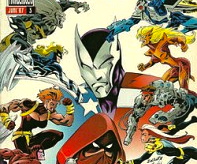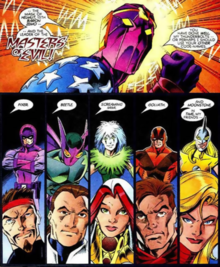Thunderbolts (comics)

Nerdlocker Comic Book Review – Thunderbolts #1
Thunderbolts #1, Writer: Daniel Way, Penciller (cover): Julian Totino Tedesco
Artist: Steve Dillon, On Sale Date: December 5, 2012, Publisher: Marvel Comics.
If you’ve read it let us know what you think in the comments below!
Special thanks to Marvel Comics. For more info on comics, video games, movies and anything else nerd, check out Nerdlocker.com, a place for your inner nerd.
 Thunderbolts #3 (June 1997). Cover art by Mark Bagley and Vince Russell from top right: Mach-1, Meteorite, Techno, Songbird, Atlas. Center top: Citizen V.
Thunderbolts #3 (June 1997). Cover art by Mark Bagley and Vince Russell from top right: Mach-1, Meteorite, Techno, Songbird, Atlas. Center top: Citizen V.
The Thunderbolts are a Marvel Comics superhero team, which consists mostly of reformed supervillains. The group first appeared in The Incredible Hulk #449 (January 1997), and was created by Kurt Busiek and Mark Bagley.
Publication history
The Thunderbolts were first presented as a group of superheroes like the Avengers, both to readers and to the Marvel Universe, who became heroes to help protect the world when the Avengers were declared dead after the events of the 1996 “Onslaught” crossover. However the final page of the first issue of their comic book revealed that the Thunderbolts were the Masters of Evil in disguise, a surprise twist carefully guarded by Marvel.
Themes of redemption and the nature of heroism are often featured in Thunderbolts comics. In subsequent storylines, the group rejects their leader Baron Zemo and attempts to become heroes in their own right, eventually under the leadership of the Avenger Hawkeye. The book has also garnered critical praise for its use of secondary characters from other Marvel Comics and its use of continuity-themed storytelling.
The Thunderbolts was an original concept created for Marvel Comics by Kurt Busiek and Mark Bagley. Most of the characters used in the final concept were reimagined versions of existing Marvel characters, with additional original characters for the series developed by Busiek and designed by Bagley. The pair also created the new heroic identities for the Masters of Evil. Busiek recalled:
The actual origin of Thunderbolts came when I used to live in New Jersey and drive to New England to visit my parents. To keep myself awake, I’d give myself books to write, and work out about two to three years of continuity. One trip, I assigned myself Avengers, and came up with the plan that the Masters of Evil would ultimately conquer them by posing as new heroes and slowly replacing them. At the time, I thought it was a neat idea, and filed it away.
The Thunderbolts first appeared as a team in The Incredible Hulk #449 (January 1997), written by Peter David and illustrated by Mike Deodato. Originally intended to be a similar team known as the “Echelon,” the synchronization of the plans led to the Thunderbolts being used instead as a “teaser” for their own series. No mention was made of the connection between the Thunderbolts and the Masters of Evil in this appearance, save perhaps for the Hulk almost recognizing Meteorite’s voice (having fought Moonstone before). The twist would not be revealed until the first issue of their own series.
Soon after the publication of The Incredible Hulk #449, the team’s own series premiered. The first issue, cover dated April 1997, was played largely as a straight superhero story, until the revelation of the Thunderbolts’ true nature on the last page of the comic. This is considered one of the most well-conceived plot twists in the history of American comic books, with Wizard magazine readers voting it “Comics’ Greatest Moment of 1997” and later, in 1999, placing it at #11 on a list of “The 25 Greatest Comic Moments Ever.” Marvel managed to keep the secret of the Thunderbolts’ true villainous identities tightly under wraps before the book launched. When word got out, the first issue sold out so quickly that Marvel not only offered a second printing, but also did a “mini-trade paperback” collecting the first two issues. Fabian Nicieza replaced Busiek in issue #34. Patrick Zircher, after a couple of fill-ins, replaced Bagley in issue #51.
The team also appeared in a one-shot called Tales of the Marvel Universe.
Despite critical acclaim, the book was reformatted with Thunderbolts #76 (March 2003), removing the entire cast and creative team and replacing it with a brand new set of characters, along with a new writer, John Arcudi. The move was done in part due to Marvel Editor-in-Chief Joe Quesada‘s desire to emulate the success he had with X-Force, which was reformatted with a new cast of characters and status quo that was successful in sales and popularity. However, the new direction for the series—an underground fighting circuit that employed predominantly newly created super-villain characters—was a commercial failure and canceled after six issues.
In 2004, Marvel Comics launched a limited series titled Avengers/Thunderbolts, which continued one year after the events of issue #75. The limited series ran for the same number of issues as the reformatted Thunderbolts arc.
Soon after the completion of Avengers/Thunderbolts, Marvel Comics launched a second series featuring the characters with New Thunderbolts #1 (January 2005). The storyline continued the events from Avengers/Thunderbolts as well as the fall-out of “Avengers Disassembled” and returned to the original series concept, though with a roster that lacked many fan favorites (such as Baron Zemo, Moonstone, and Techno). With the combination of the eighty-one issues of the first series and the first eighteen issues of New Thunderbolts, the series reverted to its original numbering with Thunderbolts #100.
Thunderbolts #110 saw another change to the direction of the series, with writer Warren Ellis introducing a new team of Thunderbolts, villains working for the government, tasked with capturing unregistered superheroes. Ellis has stated that he chose to approach the series “gently, but directly from a political agenda” and the relaunch was closely tied to Marvel’s commercially successful Civil War event, with the team serving as a dark reflection of the event’s controversial ending. The Thunderbolts also feature in the Spider-Man storyline “New Ways to Die“, which is the first proper showdown between him and the team.
Ellis stepped aside in issue #121 and was replaced by Christos Gage, who wrote three one-shots and a four-issue tie-in with Secret Invasion. At the 2008 San Diego Comic Con, Andy Diggle was announced as the new ongoing writer, starting in issue #126 (November 2008) with a two issue story “Burning Down the House” which cleared the way for the introduction of a new team line-up. This team debuted in Thunderbolts #128-129, a story that dealt with “Dark Reign“, the Secret Invasion aftermath, which was followed by “Magnum Opus”, a 4-issue crossover with Deadpool (vol. 2). Miguel Sepulvida took over art duties with Thunderbolts #133 and Jeff Parker became the new writer with issue #138. Parker then piloted the title through the end of “Dark Reign”, featuring a crossover with the Agents of Atlas team he was also writing, and into “Siege“, following which the team was revamped again. Parker announced that “the status quo of the team undergoes a major overhaul for the new era to come. It’s going to synthesize a lot of what readers like about recent history and re-instill some elements from the early days of the book.”
The Heroic Age team debuted in Thunderbolts #144 with a new main artist, Kev Walker. The title crossed over with Avengers Academy in issue #147, which was bookended by Avengers Academy #3 and #4. The series then went on to cross over with the Daredevil storyline “Shadowland” in issues #148-149, with artist Declan Shalvey stepping in for the two issues. The series then crossed over with the “Fear Itself” storyline in issues #158-163.
The Thunderbolts comic book was renamed Dark Avengers beginning with issue #175, but the creative team remained unchanged.
Fictional team biography
 The Thunderbolts’ true identities as the Masters of Evil is revealed. Art by Mark Bagley.
The Thunderbolts’ true identities as the Masters of Evil is revealed. Art by Mark Bagley.
Secret origins
The death of the superheroes created an opportunity for Zemo and the Masters of Evil. Zemo realized that the world needed superpowered champions, and that his team could fill that need. By posing as superheroes, the Masters of Evil could gain the public trust and build a position of power that rivaled the status of the Avengers. Once they had gained the public’s faith, Zemo believed they could gain access to all the secrets of the Avengers and the paramilitary organization S.H.I.E.L.D. once they were in ultimate power. Zemo then planned to sell the secrets they found to the criminal underworld. Baron Zemo summoned several of his former allies from the fourth incarnation of the Masters of Evil during a rescue attempt of Goliath (Zemo’s father’s former bodyguard). The summoned members included Beetle, Fixer, Moonstone and Screaming Mimi. Zemo took the accidental gathering as an omen, and decided to reform the Masters of Evil and attack the Avengers. Before they could strike, the Avengers (and many other Marvel Universe superheroes) were apparently killed by the villain Onslaught.
Justice, Like Lightning
The villains adopted new heroic costumes and codenames. Baron Zemo became the patriotic American Citizen V, patterned after a WWII hero his father killed. Former Spider-Man foe Beetle became MACH-1. Fixer became the gadget-wielding Techno. Goliath became the powerhouse Atlas. Screaming Mimi became Songbird. Moonstone was secretly freed from the Vault and added to the team by Zemo, who extracted a promise of loyalty from her. She was to be Zemo’s personal enforcer against any betrayal committed by the others. She took the alias Meteorite. Calling themselves the Thunderbolts, the six new ‘heroes’ were ready for action.
The team found tremendous success as superheroic champions. The public began to think of the Thunderbolts as heroes. After several adventures, some of the villains began to think of themselves the same way. Dallas Riordan, an aide to the Mayor of New York, befriended the new heroes.
Jolt, an Asian American teenage girl whose entire family was killed by Onslaught, soon joined the team. Jolt, however, was not a supervillain. The young girl honestly believed that her new friends were heroes. Soon after the addition of Jolt, Techno’s neck was broken in battle with the Elements of Doom. Techno then seemingly transferred his mind into an android body built from his tech-pack.
Return of the Heroes
Just as Zemo’s plans were about to come to fruition, everything unravelled. To the astonishment of the entire world, the Fantastic Four and the Avengers returned. Faced with the return of the lost heroes, Zemo revealed the true nature of the Thunderbolts to the world. Ostensibly, he did this to ensure the loyalty of the team by ruining their chances of becoming heroes.
The Thunderbolts (minus the android Techno) turned on Zemo for his betrayal. In the ensuing battle, Zemo and Techno used amind control device to turn the Avengers and Fantastic Four against the remaining Thunderbolts, who, with the help of the size-changing Atlas, ultimately rallied and freed the other heroes. Together, they defeated Zemo and Techno. Unbeknownst to his teammates, Atlas helped the wounded Zemo escape, while Techno fled under his own power.
Amidst this chaos, Meteorite decided to return to her old identity. She altered her costume and changed her codename back to Moonstone. After a brief stop-over in an alternate dimension, the team learned that Moonstone had no intention of reforming and becoming a superhero. She told them she only turned against Zemo out of self-preservation.
Upon their return to Earth, the team set up shop in Colorado and pondered their next move.

